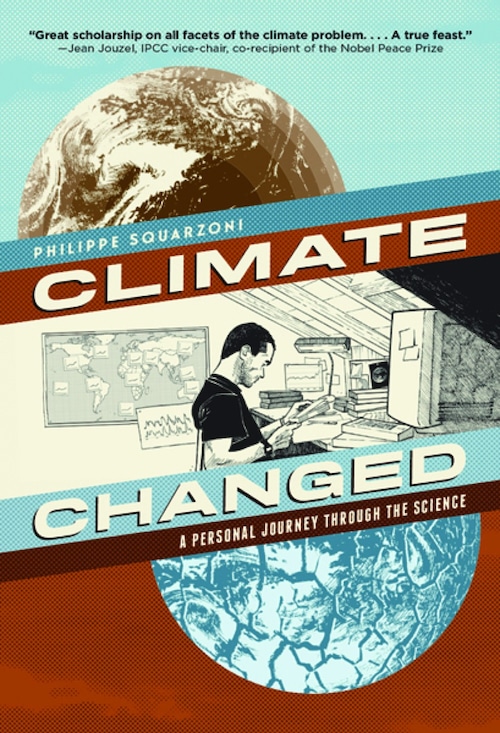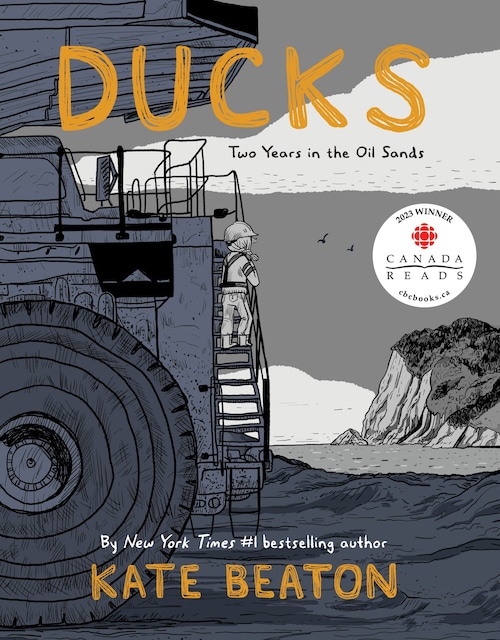
As hurricanes, drought and the other symptoms of our climate crisis become increasingly present in our daily lives, many of us are looking for ways to learn more about our changing world. The following beautiful and entertaining works of graphic nonfiction also grapple with difficult issues regarding climate change, fossil fuel extraction and the loss of once-natural spaces, for readers of all ages.
Climate Changed: A Personal Journey through the Science, Philippe Squarzoni (2014)

Abrams Books
Imagine a documentary, but portrayed in squares of cartoons and lines of text, or a textbook on climate science, but much more engaging and with much better pictures. Climate Changed by French cartoonist Philippe Squarzoni takes readers through his own quest to learn about the science of climate change, after he realized that he knew next to nothing about it. Deftly combining research, personal reflection, interviews with climate experts and stunning black-and-white visuals, Squarzoni teaches readers about the basics of climate change, breaking down difficult concepts like atmospheric science, the benefits and drawbacks of renewable energy options, the IPCC, and how we got here — that is, at the center of a climate crisis — in the first place. At nearly 500 pages, it’s no light read, but the subject matter isn’t light either, and nearly a decade after its publication, the book is still highly relevant and beneficial to all readers hoping to understand more about our changing planet.
Paying the Land, Joe Sacco (2020)

Macmillan Publishers
Joe Sacco’s 2020 blend of comic and journalism, Paying the Land, centers around the Dene people — an indigenous group in the Northwest Territories of Canada in the Mackenzie River Valley — and the mining industry that began to encroach in the late 1800s. Mining for oil, gas and diamonds brought jobs to these territories, and with it, waste, scarred landscapes, pipelines and development, as well as rising rates of alcohol abuse and other social problems. Sacco explores the benefits and the steep costs of mining on the Dene people, to whom the land was essential to their livelihoods and ways of being — and which they believe cannot be owned in the first place. He digs into the history of the region, including the residential school system that isolated indigenous children from their families and culture, and how the Dene came to rely on wage labor.
The book’s name is derived from the long Dene tradition of repaying the land when something is taken from it, thereby allowing the earth to continue sustaining itself. This idea is commented on throughout the book — both visually and in words — on the fossil fuel industry’s antithetical treatment of the land, taking from it by drilling for oil and fracked gas, and leaving only toxins behind.
The book asks us to see how the fossil fuels that we use are linked to the displacement of indigenous people and the desecration of our environment, and the deep complexity of these issues.
Ducks: Two Years in the Oil Sands, Kate Beaton (2022)

Drawn & Quarterly
In 2008, hundreds of migrating ducks died after landing in the oil sludge of Alberta’s oil sands. This graphic memoir chronicles Kate Beaton’s time as a laborer in those sands, trying to pay off her student loans during the lucrative Alberta oil rush. Against a backdrop of Canada’s stunning landscapes, Beaton’s illustrations of industrial development and razed earth show the visible and devastating impact of the oil sands on the environment. During her two years on the job, Beaton faces harassment, misogyny and threat of violence from the men she works alongside. The book exposes the trauma and hardship inherent to this kind of work that isn’t often discussed. She considers the land that was taken from First Nations people for this industry, and how they’ve become economically wrapped up in the oil sands, but have also suffered from higher rates of cancer. Ultimately, the book serves as a critique of the way we cheaply, irresponsibly and violently source our energy.
Oak Flat: A Fight for Sacred Land in the American West, Lauren Redniss (2020)

Penguin Random House
In Oak Flat, artist and writer Lauren Redniss follows the long battle of the Apache people to save their land from development. The title refers to Oak Flat itself, a mesa in southeastern Arizona near the San Carlos Apache Indian Reservation. The site has historical and cultural significance to the Apache people as an ancient burial ground, and as the place where young Apache women hold their coming-of-age Sunrise Ceremony. Ten years after copper reserves were discovered in the area in 1995, a law passed that transferred ownership of the land to Resolution Copper, which is still planning mining development that would alter this landscape forever. While the company has promised jobs — an attractive prospect in an area that has faced much economic hardship — skepticism and fear of another boom-and-bust cycle pervades in the divided community. The book is structured around interviews with native people who live near Oak Flat — two families in particular, including one of an Apache teenage activist, and a mining family. Through it all, Redniss’ vibrant and colorful pencil sketches of the landscape and its people depict the beauty of Oak Flat.
The post 4 Must-Read Graphic Nonfiction Books About the Environment appeared first on EcoWatch.
